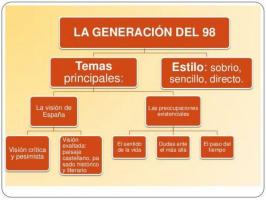Literary Analysis of Crime and Punishment
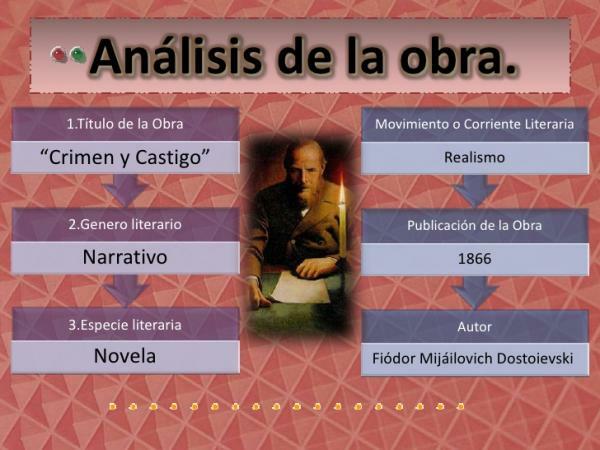
Image: Resumiendolo.com
Crime and Punishmentit is a novel by the author Fyodor Dostoyevsky published in 1866 for the first time in the magazine "The Russian messenger", in twelve parts that were later collected in a novel. It is a work of a psychological nature that deals with themes such as guilt, murder, redemption... between many more. Famous internationally, in a PROFESSOR we bring you the literary analysis of Crime and Punishment so that you better understand the relevance of this work and the depth of the topics covered.
Index
- The author of Crime and Punishment
- Brief Summary of Crime and Punishment
- The characters of Crime and Punishment
- Main Topics of Crime and Punishment
- Style of the work
The author of Crime and Punishment.
Fyodor Dostoyevsky was born Moscow in the year 1821. Along with other authors such as León Tólstoi, he is the most appreciated representative of Russian realism in his country and internationally. His mother was a sweet woman in whom the author found affection, but she died prematurely and
he was educated by his father, a man of despotic character who after the death of his wife began to consume a lot of alcohol.Dostoyevsky began to write this work in the year 1865 in a situation similar to that of the protagonist -Rodion Raskolnikov- when he had lost practically all his earnings by playing roulette and to subsist he was forced to pawn clothes, jewelry and other objects of value. The publication of"Crime and Punishment" spelled the end of their money problems and the consecration of his career as a writer.
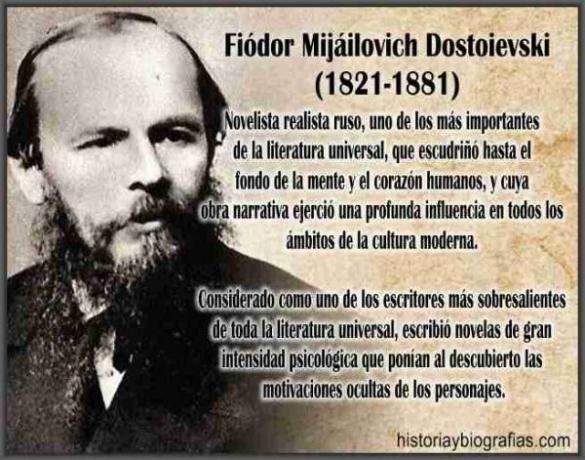
Image: History and Biographies
Brief summary of Crime and Punishment.
The play narrates the life of Rodion Raskolnikov, a student from the capital of Russia who is forced to suspend his studies due to the poverty and misery in which his family finds himself. Since he was so in need of money to pay his expenses, turn to an old moneylender where he pawns some of his objects. His sister Dunia, who wants to help him, marries a wealthy lawyer without consulting him, something that drives the protagonist to anger.
Rodion has airs of greatness and in his anger and delusions, he begins to fantasize about killing the old moneylender, causing desire to grow inside him like a seed. The protagonist ends up committing the crime and the memory of him begins to torture him, he tries to prevent the committed act from coming to light. Rodion's pride is unleashed as he contemplates that he has not gotten any satisfaction from his plan. The way in which all these thoughts and feelings are narrated almost as if it were a surgeon, a deep analysis that shows us the Man's struggle against his conscience.
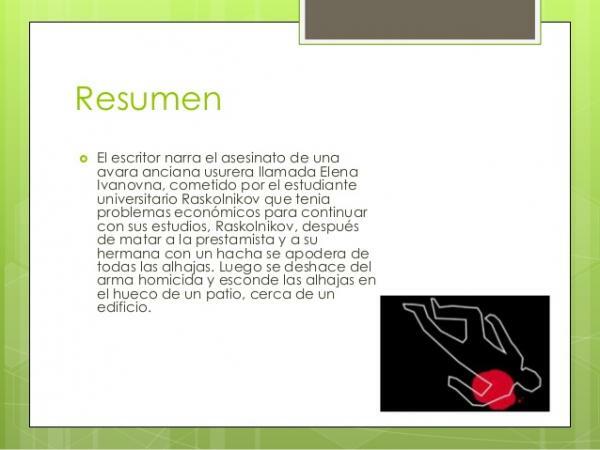
Image: Slideshare
The characters of Crime and Punishment.
To continue with this literary analysis of Crime and Punishment it is important that we stop to get to know its characters better. Here we discover what are the main and secondary characters that you will find in the work.
Main
- Rodion Raskolnikov: Main character of the novel. Guy nervous and very intelligent who lives in a pension while studying. Due to economic reasons, he is forced to drop out of school and that is when he begins to fantasize about the idea of killing his usurer to keep all his money. He is a complex character.
- Sonia Semenovna: Another of the main characters. An eighteen-year-old girl who will enter Rodion's life to be able to see the good part of her and offer her love in moments of despair and character crisis.
Secondary characters
For this literary analysis of Crime and Punishment we will also mention the secondary characters, not so important in the work but also with their psychology and contributions.
- Avdotia Románovna Raskólnikova: Sister of the main protagonist, she decides to marry a wealthy man to help Rodion. However, her circumstances will make him change his destiny to end up meeting with her brother's best friend.
- Aliona Ivanovna: Rodion's Homemade, old and moody with whom the protagonist will fantasize about her death.
- Arcadio Ivanovich Svidrigailov: Antagonistic character in the novel. She embodies the evil and corruption of the story, although she will take unexpected turns around the guilt theme.
- Marta Petrovna Svidrigáilova: Former patron saint of Dunia and Arcadio's wife, for which she was murdered.
- Porfirio Petrovich: Judge assigned to investigate the death of the usurer. Rodion will keep great reflections through him.
- Dimitri Prokófich Razumijin: Friend of the main protagonist and nephew of the judge. He will be the first to find out what his friend has done.
- Katerina Ivanovna Marmeládova: Marmeládov's wife. She will go mad a victim of tuberculosis.
- Pulkeria Aleksándrovna Raskólnikova: Mother de Dunia and the main protagonist. Humble woman that he will feel sorry for her son.
- Pyotr Petrovich: He is he wealthy sir who will ask for Dunia's hand at first.
- Semyon Zakharovich Marmeládov: Sonia's father who will serve as nexus so that she and the main character get to know each other.
- Lizaveta Ivanovna: Sister of the usurer but different from her. She is noble and kind although she will also end up being killed by Rodion, who will mourn her death.
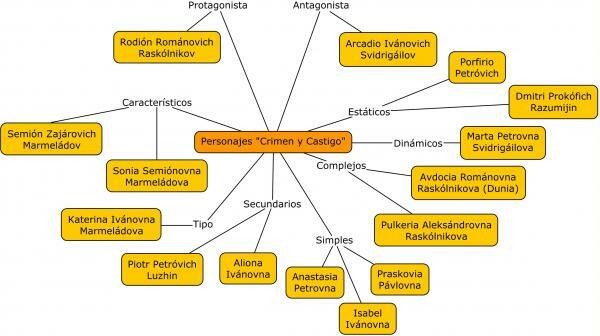
Image: Emaze
Main themes of Crime and Punishment.
The main topic of the novel revolves around Rodion's fight against his own conscience dfter having committed murder for the sole reason of asserting his "me" and show that you are not carried away by society.
"Crime and Punishment" she is also a thesis novel. Her main thesis is that the materialistic conception of western life it does not serve as a basis for exercising moral conduct, thus inevitably leading to destructive consequences and acts for the individual and for society, such as the decline of morality in Russia, another of the main issues.
The condition of women at the time It is also reflected in the different characters and is another of the main themes, although with certain changes. Sonia embodies the role of angelic prostitute, when in 19th century Europe women tended to be classified in dichotomous conditions: they were either a domestic angel or an easy woman. Dostoyevsky, on the other hand, manages to break with that by creating to Sonia as a kind prostitute.
There are also many traits around penance and suffering, content clearly influenced by the Catholic religion that has its roots in the Gospel but in which something particularly Russian also coexists. Dostoyevsky believed that suffering for sins committed is much more valuable than any effort and path directed towards the common good, towards goodness.
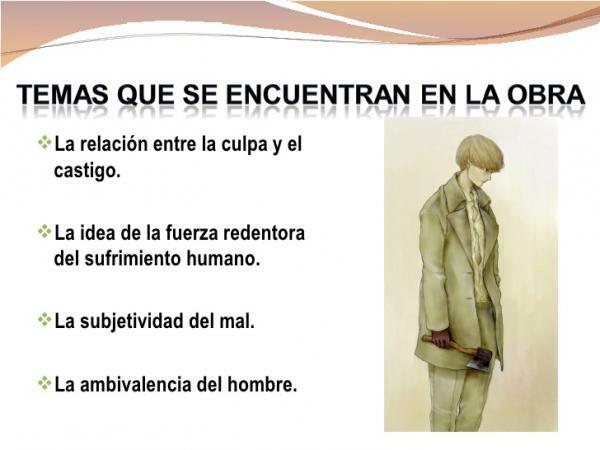
Image: Slideshare
Style of the work.
And we finish this literary analysis of Crime and Punishment to focus on its style. The style of the work is sober and uses a colloquial and standard language. Dostoyevsky was not notable for his descriptions of the places where events occurred, but rather for the psychological creation of the characters that are part of the novel, who appear normally full of contradictions and faced with great dilemmas ethical. The internal world of the character is equal to or more important than the external world.
Artistic movement
"Crime and punishment" belongs to the current of russian realism since it reflects the social problems of the time and uses an everyday language. Realist writers like Dostoyevsky assumed the right to represent everything that is seen, to try to be as sincere as possible. With this current, the ugly and the beautiful, the disgusting and the sublime, the vulgar and the extraordinary are admitted. The life of individuals becomes art, because everything can be taken to literature.
All the above makes Dostoyevsky's novel a masterpiece of literary fiction and a means of transmission and debate in turn about great knowledge and moral questions that, to this day, still concern us. In addition, with this work the writer was a pioneer in the more introspective narrative where inner dialogue prevails over descriptions. Starting in the 20th century, many great writers also began to use this type of writing, taking it as an inspiration and reference.
If you want to read more articles similar to Crime and Punishment: Literary Analysis, we recommend that you enter our category of History of Literature.
Bibliography
- Anonymous. (2016). Crime and punishment characters. The thinker
- Avilés Farré, J. (1996). The novel as a source for history: the case of "Crime and Punishment" (1866)
- Biographies and lives (2004-2019). Fyodor Dostoyevsky: Biographies and Lives, the online biographical encyclopedia.
- Durán, A. & Martínez, J. (2010). The claim of literary realism. Literature Studies (1), 91-103.
- Materano, D. (2016). Crime and Punishment Book by Fyodor Dostoyevsky. Culturagenial.com
- Navia, V. (2013). Literary analysis Crime and punishment. Prezi.com


